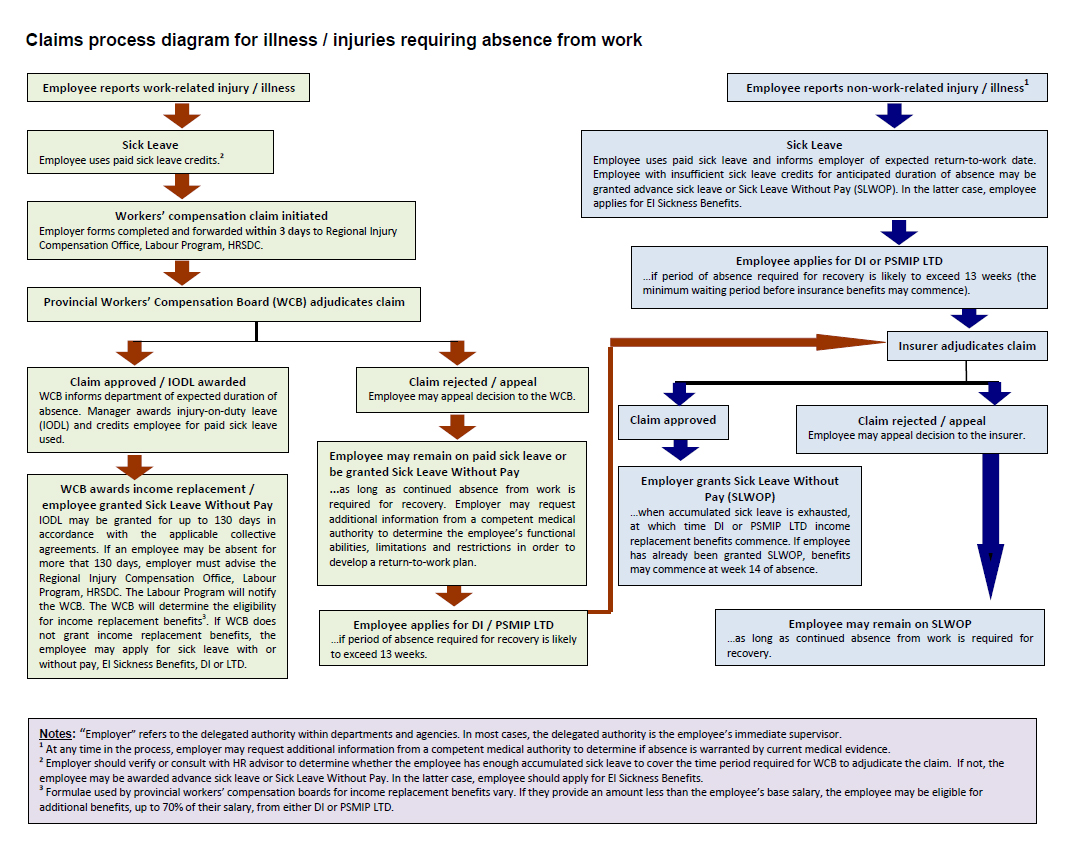Handling Disability Management Cases - Claims Process Map
Disability Management in the Federal Public Service

Figure 1 - Text version
In this process, the employer is used to refer to the delegated authority within departments and agencies. In most cases, the delegated authority is the employee's immediate supervisor.
This process occurs when:
- An employee reports a work-related injury or illness; or
- An employee reports a non-work-related injury or illness.
When an Employee Reports a Work-Related Injury or Illness
The employee uses sick leave: the employee uses paid sick leave credits. The employer should verify or consult with a Human Resources Advisor to determine whether the employee has enough accumulated sick leave to cover the time period required for the WCB to adjudicate the claim. If not, the employee may be awarded advance sick leave or sick leave without pay (SLWOP). In the latter case, the employee should apply for Employment Insurance (EI) sickness benefits.
The workers' compensation claim is initiated. The employer's forms are completed and forwarded within three days to the Regional Injury Compensation Office, Labour Program, Human Resources and Skills Development Canada (HRSDC).
- If the claim is approved and injury-on-duty leave (IODL) is awarded, the WCB informs the department of the expected duration of absence. The manager awards IODL and credits the employee for the paid sick leave used. The WCB awards income replacement and the employee is granted sick leave without pay (SLWOP). IODL may be granted for up to 130 days in accordance with the applicable collective agreements.The formulas used by provincial WCBs for income replacement benefits vary. If they provide an amount lessthan the employee's base salary, the employee may be eligible for additional benefits (up to 70 per cent of his or her salary) from either Disability Insurance (DI) or the Public Service Management Insurance Plan—Long-Term Disability (PSMIP-LTD).
- If an employee may be absent for more that 130 days, the employer must advise the Regional Injury Compensation Office, Labour Program, HRSDC. The Labour Program will notify the WCB. The WCB will determine the eligibility for income replacement benefits. If the WCB does not grant income replacement benefits, the employee may apply for sick leave with or without pay, EI Sickness Benefits, DI or PSMIP-LTD.
- If the claim is rejected, the employee may appeal the decision to the WCB. The WCB awards income replacement or the employee granted sick leave without pay (SLWOP). IODL may be granted for up to 130 days in accordance with the applicable collective agreements. If an employee may be absent for more that 130 days, the employer must advise the Regional Injury Compensation Office, Labour Program, HRSDC. The Labour Program will notify the WCB. The WCB will determine the eligibility for income replacement benefits. If the WCB does not grant income replacement benefits, the employee may apply for sick leave with or without pay, EI Sickness Benefits, DI or PSMIP-LTD. The employee applies for DI/PSMIP-LTD if the period of absence required for recovery is likely to exceed 13 weeks.
- The insurer adjudicates the claim:
- If the claim is approved, the employer grants sick leave without pay (SLWOP) when accumulated sick leave is exhausted, at which time DI or PSMIP-LTD income replacement benefits commence. If the employee has already been granted sick leave without pay (SLWOP), benefits may commence at week 14 of the absence.
- If the claim is rejected, the employee may appeal the decision to the insurer. The employee may remain on sick leave without pay (SLWOP)as long as continued absence from work is required for recovery.
When an Employee Reports a Non-Work-Related Injury or Illness
(At any time in the process, the employer may request additional information from a competent medical authority to determine if the absence is warranted by current medical evidence.)
An employee first uses sick leave: an employee uses paid sick leave and informs the employer of the expected return-to-work date. An employee who has insufficient sick leave credits for the anticipated duration of the absence may be granted advance sick leave or sick leave without pay (SLWOP). In the latter case, the employee applies for EI Sickness Benefits.
The employee applies for DI or PSMIP-LTD if the period of absence required for recovery is likely to exceed 13 weeks (the minimum waiting period before insurance benefits may commence).
- The insurer adjudicates the claim:
- If the claim is approved, the employer grants sick leave without pay (SLWOP) when accumulated sick leave is exhausted, at which time DI or PSMIP-LTD income replacement benefits commence. If the employee has already been granted sick leave without pay (SLWOP), benefits may commence at week 14 of the absence.
- If the claim is rejected, the employee may appeal the decision to the insurer; the employee may remain on sick leave without pay (SLWOP)as long as a continued absence from work is required for recovery.